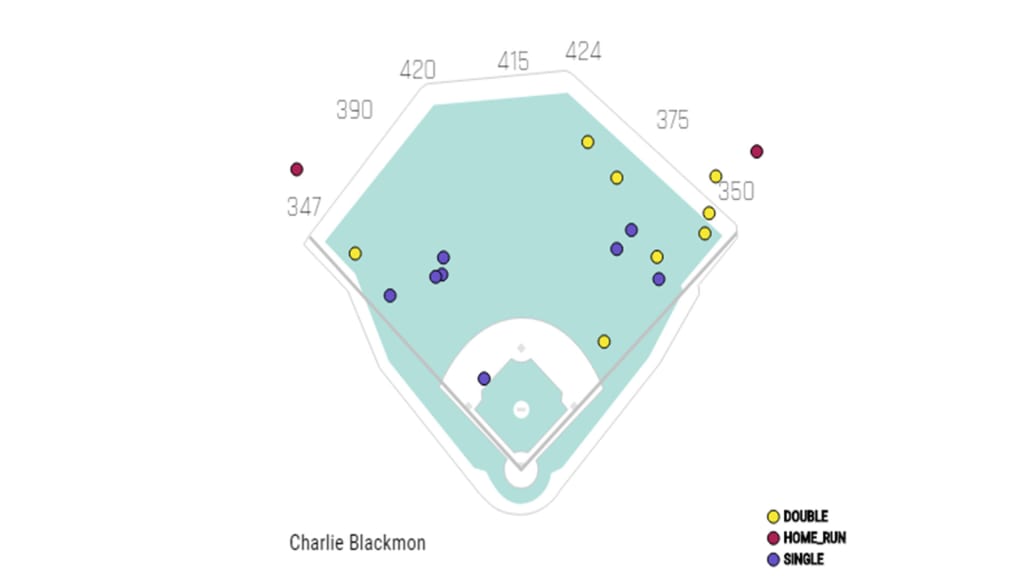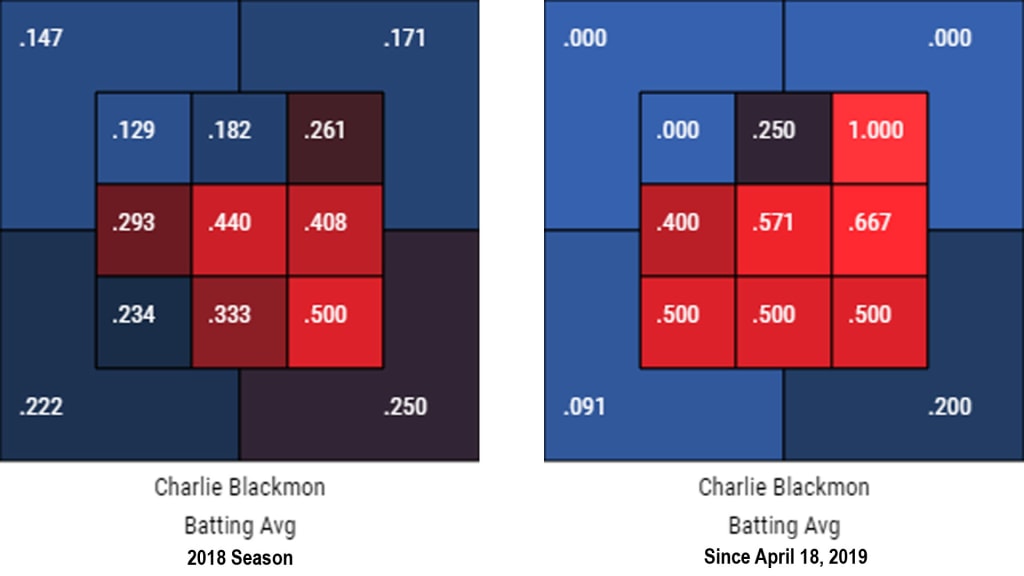DENVER -- The D-backs thought they knew Rockies right fielder Charlie Blackmon. As he has done with many opponents this year, Blackmon made them think again.
Blackmon faced Zack Greinke in the first inning of the Rockies’ 8-7 victory on Sunday with the infield shifted to the right side. In Blackmon’s history against Greinke, since Statcast began measuring in 2015, the left-handed-hitting Blackmon has sprayed his hits off the right-hander. But before Sunday, all but one of his hits to left field were harmless singles.
However, last June 8, Blackmon homered the opposite way off Greinke, and on Sunday, he proved again that he could do opposite-field damage -- this time with a hard double into the left-field corner.

By making himself harder to pitch to, Blackmon is on a torrid pace after a slow start. He’s lashing balls at different locations in the strike zone, in different counts and to different areas of the field compared to last year, when he slashed .291/.358/.502 during his third All-Star campaign.
“I’m trying to leave less on the table,” Blackmon said. “I need to be able to get hits within the entire strike zone, throughout the entire at-bat.
“I don’t want to just pull the ball. I don’t want to just hit the ball away. I don’t want to just hit the ball down, or up, or early, or late. I don’t want to give strikes away. I don’t want to give outs away. I want to be able to get hits, as much as I can.”
After struggling with a .573 OPS in his first 18 games, Blackmon had produced a 1.171 OPS in 15 games entering Tuesday night’s home contest against the Giants, during which he belted a leadoff homer. Statcast notes that before April 18, his hard-hit rate was 29 percent and barrel rate was 4.8 percent -- since then, those respective numbers have ballooned to 42.4 percent and 11.9 percent.
A detailed approach has led to the improved numbers. Here’s a breakdown:
1) Know thy strike zone: The following charts from the catcher's perspective, comparing Blackmon’s 2018 with his current hot streak, show that Blackmon has increased the number of areas that are considered “hot zones.”

“I know my strike zone,” Blackmon said. “I’m pretty much right when the ball is where I think it is. If there’s a discrepancy on whether or not I want to swing at it, or whether or not it is a ball or strike. It’s pretty much right where I thought it was.
“And sometimes that means maybe there are certain strikes I don’t want to swing at. It’s just unfortunate when certain balls that you don’t want to swing at, then you go out there and you don’t swing at them, and sometimes they’re borderline.”
2) Be shift-proof: Blackmon has been a pull hitter for much of his career, so teams shifted on him on 29.7 percent of his at-bats last season. (He hit .294 on those, by the way.) This year, the percentage has spiked to 56.1 percent, but Blackmon’s average has risen to .370. His 30 hits against the shift are second most in the Majors behind the 39 by the Dodgers’ Cody Bellinger.
“It’s just being comfortable in the at-bat, knowing what I want to do based on each pitcher, and being competitive and executing that approach,” Blackmon said. “I don’t want to be up there and say, ‘I’m going to swing at every strike.’"
3) Blackmon does Blackmon: Manager Bud Black never had to worry about Blackmon reacting to his slump by making massive changes.
“Like the hit to lead off the game the other day against Greinke -- he had a plan that he was going to take the outside pitch and drive it the other way, and he did it beautifully,” Black said. “With Chuck, his success is not happenstance.”
Here’s one for progressiveness: Blackmon, once known for laying off first pitches, has swung at 31.5 percent of those during his hot streak, and has gone 10-for-14 (.714). Last year, he swung at 22.5 percent of first pitches and went 18-for-56 (.321).
All these increases would not have been possible had he let the early slump change his goals and objectives.
“You learn, usually, that panicking only makes things worse,” Blackmon said. “Just limiting those ups and downs can really save you from getting all those gray hairs. Just trying to be even-keeled all the time is the way to go for me.”
Honorary Bat Girl
Dana Mahoney Plumhoff of Denver has been chosen as the Rockies’ 2019 Honorary Bat Girl. She will be recognized at Sunday’s game against the Padres.
Plumhoff was mourning the death of her mother, who passed away at 68 from a blood clot while attending a friend’s funeral. She devoted her time to caring for her father, who was battling Stage 3 pancreatic cancer, and caring for her adult special-needs brother all while working full-time.
But on Feb. 1, 2018, doctors discovered a lump in her left breast, and on March 1, it was confirmed as breast cancer.
“My blood froze, and my heart pounded while the person on the phone gently brought me into a whole new world, using words and phrases that were foreign to my ears,” Plumhoff wrote in her personal story. “My boss was the first person I told, and I cried. Those few minutes that afternoon was the only time I cried about my cancer.”
Her father passed away at the age of 70 on Sept. 21, 2018, but Plumhoff soldiered through the difficult treatments. She had her final one on April 1, and is continuing to monitor her health.
“People have asked me many times the past several months how I've made it through the year,” she wrote. “I tell them simply, ‘Because I had to.’ I wasn't given a choice to change anything that's happened to my family this last year. However, I had all the power in how I responded to what I was handed. I could choose to wring my hands in agony and cry, or I could fight and find the positives in everyday life. And there are many.”

